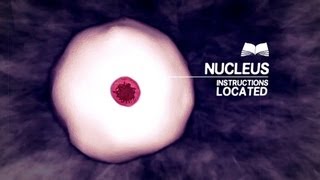(单词翻译:单击)
Every human being starts out the same way:
每个人生命都有相同的开始:
two cells, one from each parent, found each other and became one.
分别来自父亲和母亲的两个细胞,相遇并合而为一。
And that one cell reproduced itself,
接着这个细胞复制自己,
dividing, dividing and dividing until there were 10 trillion of them.
分裂,再分裂,再分裂,直到达到十万亿个细胞。
Do you realize there's more cells in one person's body than there are stars in the Milky Way?
你知道人身体细胞的数目比银河里的星星还多吗?
But those 10 trillion cells aren't just sitting there in a big pile.
但这十万亿个细胞可不是随便堆成一堆。
That would make for a pretty boring human being!
这样的人类应该看起来很无趣吧!
So what is it that says a nose is a nose, and toes is toes?
那什么决定鼻子要成为鼻子、脚趾成为脚趾呢?
What is it that says this is bone, and this is brain, and this is heart,
什么决定这个成为骨头、那个成为大脑、那个成为心脏,
and this is that little thing in the back of your throat you can never remember the name of?
那个在你喉咙深处、你一直记不起名字的东西?
Everything you are or ever will be made of starts as a tiny book of instructions found in each and every cell.
任何组成你的部分,都来自一份小小的、可在任何细胞中找到的说明书。
Every time your body wants to make something,
每次你的身体想要建造什么东西时,
it goes back to the instruction book, looks it up and puts it together.
都会回去看这本说明书,再进行建造。
So how does one cell hold all that information? Let's get small.
那细胞是如何保存这些信息呢?让它压缩变小。
I mean, really small -- smaller than the tip of a sewing needle.
我是说,非常小,比针尖还小。
Then we can take a journey inside a single cell to find out what makes up the book of you, your genome.
如果我们能走进细胞,去探究这本书的组成,我们会发现:你的基因。
The first thing we see is that the whole genome, all your DNA,
首先我们要了解基因组,也就是你所有的DNA,
is contained inside its own tiny compartment, called the nucleus.
是被存放在一个叫做细胞核的小地方。
If we stretched out all the DNA in this one cell into a single thread, it would be over 3 feet long!
如果我们把一个细胞的DNA拉直成一条线,这条线会超过3英尺!
We have to make it fit in a tiny compartment that's a million times smaller.
我们必须把它局限在一个仅百万分之一倍的小空间。
We could just bunch it up like Christmas lights, but that could get messy. We need some organization.
我们可以把它乱卷一通,像圣诞灯彩一般,但这样就太凌乱了。我们需要一些整理方法。
First, the long thread of DNA wraps around proteins clustered into little beads called nucleosomes,
首先,线状的DNA会缠绕一些蛋白质,变成称为核小体的小珠子,
which end up looking like a long, beaded necklace.
它会看起来像是一条长长的串珠项链。
And that necklace is wrapped up in its own spiral, like an old telephone cord.
接着,这条项链会绕成像是电话线一样的螺旋。
And those spirals get layered on top of one another until we get a neat little shape that fits inside the nucleus.
再来,这些螺旋会相互交迭,直到可以整齐地放进细胞核中。
Voilà! Three feet of DNA squeezed into a tiny compartment.
哇!3英尺的DNA就这样挤进小小的空间了。
If only we could hire DNA to pack our suitcases!
真希望我们可以用相同的机制打包行李!
Each tiny mass of DNA is called a chromosome.
每一小团DNA被称为染色体。
The book of you would have 46 chapters, one for each chromosome.
在这本说明书中有46章,每一章就是一条染色体。

Twenty-three chapters of your book came from your mom, and 23 chapters came from your dad.
说明书的其中23章来自你的母亲,另外则来自你的父亲。
Two of those chapters, called 'X' and 'Y,' determine if you're male, 'XY,' or female, 'XX.'
其中被称为X和Y的两章,会决定你是男生,也就是XY;或是女生,也就是XX。
Put them together, and we get two almost identical but slightly different sets of 23 chapters.
它们会组成两套几乎相同却又有些微差异的23章。
The tiny variations are what makes each person different.
这些微差异就造成了人与人之间的不同。
It's estimated that all the chapters together hold about 20,000 individual instructions, called genes.
如果把所有的章节都列入计算,大约会有两万笔说明,也就是基因。
Written out, all those 20,000 instructions are 30 million letters long!
如果把这两万笔说明全部写下来,会长达三千万个字母!
If someone were writing one letter per second,
如果人可以一秒钟写一个字母,
it would take them almost an entire year to write it once.
那也需要花将近一年才能写完一次。
It turns out that our genome book is much, much longer than just those 30 million letters -- almost 100 times longer!
然而,我们的说明书比三千万个字母还长出许多--将近是它的一百倍!
What are all those extra pages for?
那这些多余的书页又写了些什么呢?
Well, each page of instructions has a few pages of nonsense inserted
嗯,每部份的说明都会插入几页无意义的编码,
that have to be taken out before we end up with something useful.
我们必须先将这些乱码移除才能看到有意义的信息。
The parts we throw out, we call introns. The instructions we keep, we call exons.
这部分我们移除的乱码被称为内含子,而保留下来的信息被称为外显子。
We can also have hundreds of pages in between each gene.
我们的基因与基因之间也可能有几百页的乱码。
Some of these excess pages were inserted by nasty little infections in our ancestors, but some of them are actually helpful.
有些是在我们的祖先被病毒感染时所插入的多余页面,但也有些看似无意的页面是有用的。
They protect the ends of each chapter from being damaged,
它们可以保护章节的头尾免于破坏,
or some help our cells find a particular thing they're looking for, or give a cell a signal to stop making something.
或是帮助我们的细胞找到一个他们正在寻找的东西,也有可能是当作停止制造的信号。
All in all, for every page of instructions, there's almost 100 pages of filler.
总而言之,在每部分说明中,大约包含着一百页的内容。
In the end, each of our books' 46 chapters is between 48 and 250 million letters long.
最后,这本书46章的每章长度,会介于4800万到2.5亿个字母那么长。
That's 3.2 billion letters total!
共计三十二亿个字母!
To type all that copy, you'd be at it for over 100 years, and the book would be over 600,000 pages long.
若以打字方式复制,你需要花上一百年,而且这本书会超过六十万页。
Every type of cell carries the same book,
每一种细胞都带有相同的说明书,
but each has a set of bookmarks that tell it exactly which pages it needs to look up.
但是会有不同的索引帮助搜寻它们需要看的页面。
So a bone cell reads only the set of instructions it needs to become bone.
所以骨细胞只会看和生成骨头相关的指引。
Your brain cells, they read the set that tells them how to become brain.
你的脑细胞会阅读组成大脑所需的部分。
If some cells suddenly decide to start reading other instructions,
如果一个细胞突然开始阅读其他的指引,
they can actually change from one type to another.
他们就可以从一种细胞转换成另一种。
So every little cell in your body is holding on to an amazing book, full of the instructions for life.
你身体里每一个细胞都带着这本神奇的书,这本书充满对生命所有的批注。
Your nose reads nose pages, your toes read toes pages.
你的鼻子阅读关于鼻子的部分,你的脚趾则阅读关于脚趾的部分。
And that little thing in the back of your throat?
而你喉咙深处的那个小东西呢?
It's got its own pages, too. They're under 'uvula.'
它也有属于自己的章节。就是标示‘悬雍垂’的那几页。


